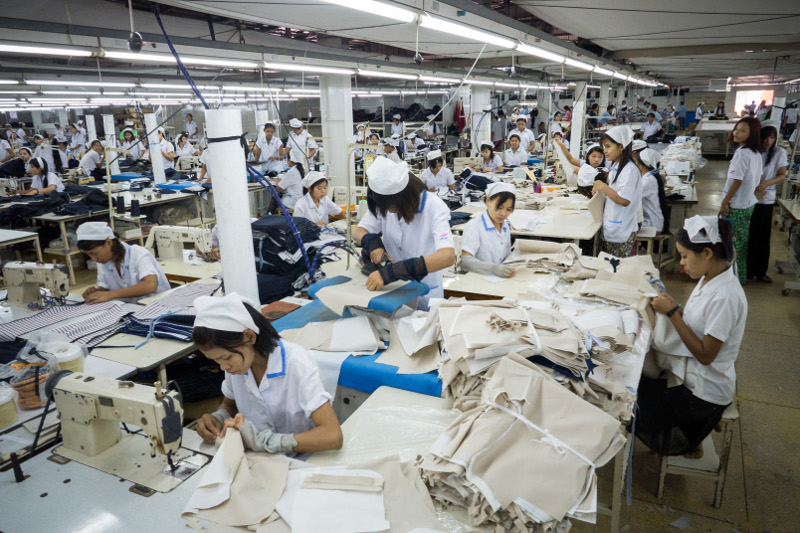Mekong Forum Looks at Ways to Promote Healthy Economic Zones

Economic zones hold unique health risks for both workers and communities, but they also offer opportunities to protect workers’ productivity and improve community health. Photo: ADB.
Economic zones are growth engines of the Greater Mekong Subregion, stimulating economic activity and creating jobs. Yet, not much attention has been given to the social and health aspects of economic zone development until recently.
A regional consultation forum was held in Ho Chi Minh City this month to explore harmonized approaches to health risk management in economic zones in the subregion. Delegates from Mekong countries, including health and economic zone authorities, attended the forum, which was organized by the Asian Development Bank (ADB) last 16 August.
Sustainable economic growth and a healthy population are interconnected, said Director General Nguyen Thi Lien Huong of the Viet Nam Health Environment Management Agency, who opened the forum.
Investments in development projects, including infrastructure, can affect human health in many ways, both good and bad. Effects range from the spread of infectious diseases to occupational injuries, lifestyle changes that lead to higher risk of non-communicable diseases such as hypertension and diabetes, and environmentally caused diseases from exposure to pollution.
Solid policy formulation to protect people in economic zones and improved health systems are important in responding to the health challenges and opportunities of development, Nguyen said. There is also a need to strengthen national capacity for conducting health impact assessments.
The HIA approach
A health impact assessment (HIA) is an evidence-based approach to protecting public health and mitigating the negative impact of development projects, particularly on vulnerable communities. ADB has helped countries in the Greater Mekong Subregion develop an HIA framework to ensure that both businesses and communities benefit from economic zone and border area development.
Susann Roth, senior social development specialist at ADB, said HIA can be used as a management tool in these economic zones to promote sustainable economic, social, and health development. Roth led the development of the HIA framework at ADB and HIA scoping in selected economic zones in the subregion over the last 3 years.
The six countries that make up the subregion—Cambodia, People’s Republic of China (specifically Yunnan Province and Guangxi Zhuang Autonomous Region) Lao People’s Democratic Republic, Myanmar, Thailand, and Viet Nam—have created more than 500 special economic zones along or near border areas to boost regional trade and investments. These economic zones hold unique health risks for both workers and communities, but they also offer opportunities to protect workers’ productivity and improve community health.
Health risks and preventive care
Among the risks are transboundary health issues, which may affect not only people’s wellbeing but also businesses.
“Health hazards cross boundaries,” said ADB consultant Filipe Silva at the forum. These include communicable and vector-borne diseases, such as tuberculosis, dengue, and malaria, and air and water pollution. He said economic zones, which tend to draw migrant workers, and their surrounding communities should be protected from these health risks.
ADB consultant Janis Shandro observed however that many economic zones and border areas in the subregion lack health planning and management, which is not good for public health and for business. She said studies estimate the rate of return for investing in preventive healthcare at more than $1.60 to $2.50, whereas just a single outbreak can halt businesses or even lead to their closure.
She said the HIA framework provides tools and a step-by-step process that may be applied systematically to economic zone development—from site preparation and clearance to construction, operation, and expansion—in any country.
Some countries in the subregion already have HIA policies while others are moving toward strengthening health components within their environmental impact assessment process.
Three paradigm shifts
Roth said there is still a need for more ambitious regional and national policies with clear targets for HIA enforcement and for harmonized approaches to managing health risks in the subregion. She prescribed three paradigm shifts to maximize health outcomes from economic zone and border area development. First, put in place policies that require economic zones to conduct not just an environmental but also a health impact assessment. Second, promote healthy infrastructure and economic zone development by providing health certification. Third, use HIA as a management tool for integrated, cross-sector economic zone development.
She said there are plans to present the outputs of regional consultations on HIA at the GMS Economic Corridor Forum in December with the objective of making it an integral part of economic corridor and border area development.
Participants at the forum shared their experiences in addressing health risks and opportunities in economic zones. Among the key points raised were the lack of baseline health data on economic zones and affected communities, and the need for cooperation on transboundary health issues, not just on infectious diseases but also pollution.
The participants were also given the opportunity to apply the HIA scoping tool during a site visit to the Hiep Phuoc Industrial Park in Ho Chi Minh City
Last Updated: 22 August 2018
